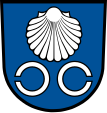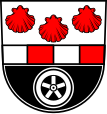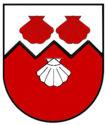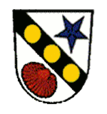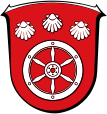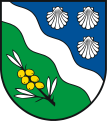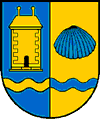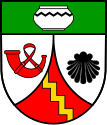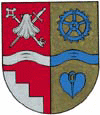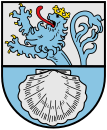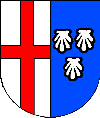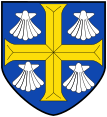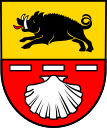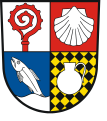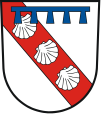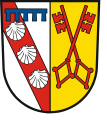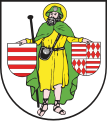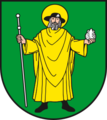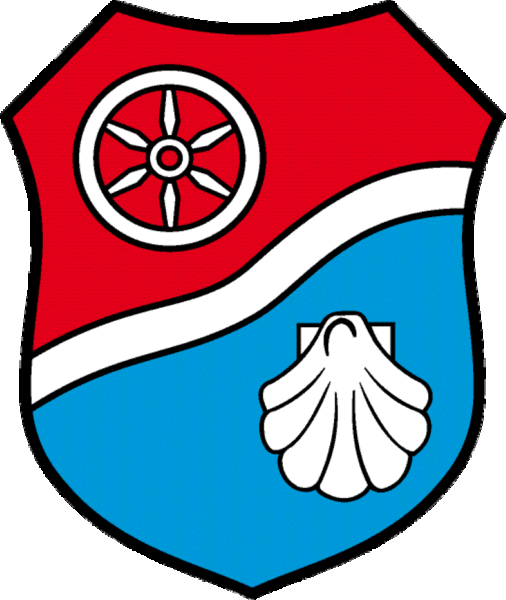List of municipal coats of arms with the scallop shell in Germany
This article contains the list of municipal coats of arms with the scallop in Germany .
With scallops , in heraldry often scallop called, are two closely related species of shellfish called, both to the genus Pecten belong. The name scallop goes back to Saint James , the patron saint of pilgrims , whose distinguishing mark is the shell.
Baden-Württemberg
Amstetten - Bräunisheim (old), Alb-Donau-Kreis
In red an inclined left-facing golden key, accompanied by two silver shells.
Explanation: The coat of arms designed in 1954 is reminiscent of the Counts of Dillingen , the oldest known lords of Bräunisheim; the key symbolizes the apostle Peter , after whom the Bräunisheim church is named; the shells are a symbol of the apostle James the Elder, to whom the church in Sontbergen is dedicated.
Bad Schönborn - Bad Mingolsheim (old), district of Karlsruhe
In blue a silver shell over two adjacent silver rings that are open on the outside.
Explanation: The silver rings indicate Saint Rochus, who was included in the coat of arms as the local patron; they symbolize the prison rings of Saint Roch , who was imprisoned as a pilgrim and "plague saint " in his hometown of Montpellier in the south of France .
Berkheim , District of Biberach
In red a golden pilgrim's hat with a golden cord all around, tied twice at the front and ending in two tassels, accompanied by two golden shells at the top
Explanation: On November 18, 1957, the municipality received permission from the Ministry of the Interior to create a coat of arms with two golden pilgrim shells and to lead the golden pilgrim hat of Saint Willebold in red .
Bermatingen - Ahausen , Bodenseekreis
Square in gold and green with a red heart sign, inside a silver shell.
Explanation: The gold and green squared shield is the coat of arms of the Lords of Ellerbach , which is proven in Ahausen in the 15th century ; the silver shell refers to the St. James chapel in the village.
Dörzbach , Hohenlohekreis
Above a four-fold silver and red bar, three (2: 1) red shells, underneath a five-spoke silver wheel in black
Explanation: On June 27, 1583, Emperor Rudolf II awarded Dörzbach a coat of arms along with the market rights, that connected the wheel from the Lords of Berlichingen with the beam from the coat of arms of an extinct local noble family. After Dörzbach was sold to the Lords of Eyb in 1601, the Eyb shells (scallops with the joint turned upwards) replaced the wheel in the upper half of the shield. In 1931 the municipality added the Berlichingen wheel to the lower (blue) half of the shield. Incorrect tinging of the shield base of the heraldic figures wheel and shells were later corrected.
Eberhardzell (old, until 1981), district of Biberach
Three overturned silver shells in red diagonal bars
Haigerloch - Bad Imnau (old), Zollernalbkreis
A silver fountain in red, each accompanied by a silver shell
Immenstaad am Bodensee , Bodenseekreis
In red within a wavy border divided by blue and silver, two diagonally crossed golden pilgrim sticks, accompanied by a golden pilgrim shell at the top and a golden cloverleaf crown at the bottom
Lonsee - Halzhausen (old), Alb-Donau-Kreis
In red a floating silver cross, angled in fields one and four by a silver pilgrim shell, in fields 2 and 3 by a fallen silver horseshoe.
Explanation: The shells are the symbol and badge of the Apostle James the Elder, the co-patron of the two churches in Halzhausen and Sinabronn on the parish marker; the cross reminds of the main title of the Holy Cross Church in Sinabronn.
Maselheim - Laupertshausen , district of Biberach
In red an overturned golden sword, accompanied by two silver shells.
Explanation: The shells and the sword are symbols of the church saints: for James the shell and for St. Pelagius the sword; the colors come from the coats of arms of the former local lords Holzapfel / Biberach and the lords of Ellmannsweiler; In its current form, the coat of arms was awarded on June 6, 1957 by the Baden-Württemberg Ministry of the Interior.
Pfullendorf - Denkingen , District of Sigmaringen
A golden high cross in red, each with a silver scallop shell
Philippsburg - Huttenheim (old), District of Karlsruhe
In blue, two silver salmon turned away by stakes over a silver shell
Stetten am kalten Markt - Frohnstetten , Sigmaringen district
Divided by silver and red, above a continuous red bar cross, below a silver shell
Explanation: The cross is taken from the coat of arms of the noble noble Buchau monastery . The shell is an attribute of Holy New Year's Eve , church patron of Frohnstetten.
Sulz am Neckar - Sigmarswangen , Rottweil district
In silver, three ascending red tips, above two red, below a silver shell
Tauberbischofsheim - Dienstadt , Main-Tauber-Kreis
In silver on a green shield base a silver bearded man in a red toga-like robe, nimbed with a gold circle, with a golden book in the angled right hand and a man-high golden pilgrim's staff, topped with a scallop shell of the same kind, in the angled one Left
Unterschneidheim - Nordhausen , Ostalbkreis
Split of silver and red, in front a continuous black bar cross, behind a silver shell.
Explanation: The German order cross has since 1313 proven rule of the Teutonic Order in Nordhausen out; the shell is taken from the coat of arms of the Barons von Eyb, it is supposed to remind of the German Commander Friedrich Carl von Eyb; under this the church was built in 1751 in Nordhausen.
Bavaria
Achslach , district of Regen
In blue a silver wave bar, above diagonally crossed two golden pilgrim sticks, covered with a silver pilgrim shell, below a gold-reinforced silver ibex trunk
Explanation: The silver wave bar, a heraldic river symbol, refers to the Teisnach and the location of the municipality in the Achslacher Valley. Shell and pilgrim sticks, attributes of St. Jacob, represent the parish church of St. Jakob , which was only built in the 19th century after Achslachs was elevated to parish (1823). The silver ibex hull is the reduced reproduction of the coat of arms of the Ramsbergers (von Altrandsberg), who owned courtyards as ministerials of the Counts of Bogen in the hamlet of Randsburg. The colors silver and blue are reminiscent of the rule of the Counts von Bogen up to 1242 and, in their successor, the Wittelsbachers , who established the district court, maintenance and caste office in Viechtach as rulers, to which the Achslach office was also subordinate.
The coat of arms hasbeen used since 1985based on a resolution by the Achslach municipal council and the approval of the Lower Bavarian government.
Anger , Berchtesgadener Land district
Two crossed silver keys in red, accompanied by a silver pilgrim shell at the top and a silver Raitel hook at the bottom
Explanation: The composition of the figures on the coat of arms refers to the incorporation of the formerly independent municipalities Aufham and, which took place in the course of the local regional reform in 1978 Högl to the municipality of Anger. Elements have been adopted from the three previously used municipal coats of arms. The tinging in red and silver refers to the historical affiliation of the municipality to the bishopric of Salzburg until 1817. The crossed keys, attributes of St. Peter, remind us that Anger (until 1937 Stoißberg) was donated to the monastery of St. Peter in Salzburg and later came to the Augustinian monastery Höglwörth as endowment , which also had the crossed keys in the coat of arms as a reference to the patron saint. From the 12th to the beginning of the 19th century, the Höglwörth canon monastery, as an important manor with extensive forest holdings, was the economic, cultural and religious center of the area. The monastery coat of arms of Höglwörth, which can be traced back to the 15th century, in red two crossed silver keys, forms the basis of the municipal coat of arms of Anger. The Raitelhaken and the pilgrim's shell make special local references as additional symbols . The Raitelhaken, a lifting tool for the transport of stones, comes from the former municipality coat of arms of Högl and refers to the sandstone quarries that were operated in Oberhögl from the 16th century to 1913 and used to manufacture window and door frames, whetstones and whetstones from were of national importance. The pilgrim shell was taken from the Aufham coat of arms and, as an attribute of St. Jacob, refers to the local church patronage.
The coat of arms has been used since 1980.
Ansbach - Eyb
In red a wide, silver wave bar, accompanied by two at the top and a silver sea shell below.
Explanation: The Eyber coat of arms has shown the peacock's body for a long time. Georg von Eyb was dubbed a peacock ; from around 1400 the coat of arms shows the scallop shell in the shield, while the peacock's trunk moved into the upper coat of arms. According to legend, Ludwig II of Eyb was awarded three red seashells on a silver shield by Emperor Ludwig the Bavarian in 1352 after a pilgrimage (1341) to Palestine .
Bad Aibling - Willing , district of Rosenheim
In blue over three lowered golden wavy bars, a stylized, overturned, silver pilgrim shell
Deisenhausen , District of Günzburg
Split, in the front in pewter cut divided by black and silver, behind in red two crossed pilgrim's sticks, each with a silver pilgrim shell at the top and bottom
Explanation: The community of Deisenhausen consists of the formerly independent communities Deisenhausen, Oberbleichen and Unterbleich. In the course of its history, the places experienced different rulers, mostly patrician families from Augsburg and Ulm as well as religious institutions. Three of them are represented on the municipal coat of arms, representing the others. The pewter cut comes from the coat of arms of the Ungelter family in Ulm, who also called themselves Ungelter von Deisenhausen and is documented in Deisenhausen from 1409 to 1554. The colors black and silver indicate the Vöhlin von Frickenhausen family , who had had important rulership rights in Oberbleichen since 1524 and in Nordhofen since 1560 in what is now the municipality. The two crossed silver pilgrim sticks with the silver pilgrim shells are taken from the coat of arms of the Jakobsspital in Augsburg, which ruled Deisenhausen since 1679. The monastery coat of arms carried the pilgrim's staff and the shell, both attributes of St. Jacob in the monastery coat of arms. - The coat of arms has been used since 1980.
Effeldorf , part of the town of Dettelbach in the Lower Franconian district of Kitzingen
In silver, two diagonally crossed blue pilgrim poles, each with a blue pilgrim shell; A red heraldic rose with golden lugs and green sepals at the top and bottom.
Explanation: Pilgrim staffs and clams refer to St. James. The colors silver and red in the coat of arms refer to the rights of the Castell , which they had in the 13th century , while white and blue to the later relationships between Effeldorf and the University of Würzburg .
Feldkirchen , District of Munich
Split by blue and silver; to the left, above a lowered silver oblique left-hand bar, a golden shell; on the right a blue sphere from which a blue cross arises
Explanation: The shell, an attribute of St. Jacob, refers to the patron saint of the Catholic parish church of Feldkirchen, the church on the field that gave the place its name. The silver sloping bar symbolizes the old road leading through Feldkirchen , which was particularly important for the salt trade . The globe with the cross indicates one of the oldest Protestant parishes in Upper Bavaria and its diaconal institutions. The Bavarian elector, or from 1806 King Maximilian I Joseph , promoted the influx of Protestant colonists from the Palatinate on the left bank of the Rhine from the beginning of the 19th century. These so-called Überrheiner built the neo-Romanesque church in 1837. The field colors silver and blue underline the close ties to the Wittelsbach house.
The current coat of arms of the municipality goes back to a municipal council resolution and the approval of the State Ministry of the Interior on February 4, 1970.
Fischach - Willmatshofen , Augsburg district
In silver, a red sloping bar covered with three silver shells, each accompanied by a six-pointed red star.
Explanation: The coat of arms symbolizes the development of the manorial rule in Willmatshofen; The Schmucker family (2 stars) held the family, followed in 1616 by the family of Konrad Peutinger from Augsburg (a red sloping bar covered with three silver shells in blue).
Frauenneuharting , District of Ebersberg
In silver, a black sloping bar covered with three golden balls, accompanied by a five-pointed blue star at the top and a red shell below
Explanation: The sloping bar covered with balls is derived from the coat of arms of the Lords of Pienzenau , which was used from 1381 to 1800 as Hofmarksherren were connected with Jakobneuharting, the former Neuharting, and surrounding villages. The star and shell refer to the church patrons Maria and Jakob and allude to the place names defining words "women" and "Jakob" in Frauen- and Jakobneuharting. The Marian symbol of the blue star expresses the Marian patronage of the church consecrated around 1000 and the parish name Frauenneuharting. The shell, an attribute of St. Jacob and a pilgrimage sign, alludes to the veneration of Jacob in the church of Jakobneuharting, which has been documented since the 15th century.
Germaringen - Ketterschwang , Ostallgäu district
Through a lowered silver tip, inside a green three-mountain topped with a left-facing golden scythe leaf, split by blue and red, a silver scallop shell in front, a silver Roman legionnaire's helmet at the back
Explanation: The scallop is an attribute of the apostle James the Elder, patron saint of the Ketterschwanger parish church. The Roman legionnaire's helmet embodies a bronze find from Roman times, the so-called “Ketterschwanger Tropaion” from the 1st to 2nd century AD. The green Dreiberg with the scythe leaf on top tries to put the place name in the picture. The colors green and gold are the traditional colors of agriculture.
Großlangheim , district of Kitzingen
In red a growing, gold-nimbed silver man in a long robe with a golden shell in the downward right hand and a golden walking stick in the left
explanation: From 1547 the imprint of a seal with St. James is known, the the parish church is consecrated. The depiction of the saint goes back to a seal from 1633 on which he carries a shell and a pilgrim's staff. The colors silver and red come from the coat of arms of the Counts of Castell , but also of the Würzburg state.
The Ministry of the Interior confirmed the coat of arms as depicted in 1633 on May 9, 1961.
Günzburg - Reisenburg , district of Günzburg
Kitzingen - Sickershausen , District of Kitzingen Divided by
a left-sloping golden pilgrim's staff from red and black, above a silver shell, below a silver six-pointed star
Explanation: A court seal from the 17th century shows a pilgrim with a pilgrim's staff and shell. This representation is based on a Marian pilgrimage that has been documented since the 16th century. The pilgrim symbols as well as the Marian attribute, the star, found their way into the coat of arms. The colors white and black indicate the rule of the Margraves of Ansbach, and the colors white and red of the Würzburg monastery.
Königsfeld , District of Bamberg
In red, two diagonally crossed silver flails, accompanied by a golden crown at the top, a golden pilgrim shell below.
Explanation: The royal crown stands for the place name. The two flail come from the coat of arms of the former Lords of Königsfeld, Bamberg ministerials in the service of the Counts of Truhendingen. The pilgrim's shell refers to the patron saint of the Catholic parish church of St. James the Elder.
The municipality of Königsfeld has had the current coat of arms since the territorial reform in 1973.
Langquaid , District of Kelheim
The growing bust portrait of a blue-clad, bearded man with a black pleated hat on the brim and a slanting outward-facing silver pilgrim shell on the brim and on the shoulder sides of the coat
Explanation: The saint in the coat of arms is according to recent opinion probably around St. James, the patron saint of the parish church of Langquaid. This is also supported by the heraldic attributes, the pilgrim shells on the coat and the brim of the hat. Even in Hupp (1912), the blazon of the “bust of St. Rochus “the speech, the patron saint against the plague. However, this interpretation has been abandoned, the official blazon is not fixed. The design of the saint changed repeatedly, while the tinging was fixed since the confirmation of the lost market privileges by Duke Albrecht IV in 1486. This mentions the “previous coat of arms”, that is, the beginning of the coat of arms was a long time ago. The fragment of a seal imprint from 1494 suggests that the first typar with the coat of arms was created in the early 15th century.
Marquartstein , Traunstein District
Split; in front in silver a black gable with four steps, behind in blue two crossed silver pilgrim poles, on the intersection covered with a silver pilgrim shell
Explanation: The stepped gable is the coat of arms of the noble family von Hohenstein, passed down on seals from the 14th century. The Counts of Hohenstein are considered to be the founders of Marquartstein Castle in the late 11th century. The rear field shows a modification of the coat of arms of the Barons of Tautphoeus (two crossed silver pilgrim sticks, accompanied by four silver shells). Cajetan von Tautphoeus acquired the dilapidated nursing home in 1857 and had it restored. - The municipal coat of arms is based on a design by Helmut von Tautphoeus.
Neuendettelsau , Landkreis Ansbach
Above a silver shield base, inside a red shell, in blue a silver Luther rose with a heart-shaped red clasp,surrounded by a gold ring, inside a black cross (Luther rose)
Explanation: The shell in the shield base is a pilgrim shell , the family coat of arms of the Barons of Eyb taken, which has been based in Neuendettelsau since 1518. The Luther Rose was chosen because the local history since Wilhelm Löhe has been strongly influenced by the ecclesiastical life of the Evangelical Lutheran Church.
Obersinn , Main-Spessart district
By a silver wave pole split by red and green, in front over three silver tips a silver shell, behind over a silver beech leaf a silver mark, which is composed of the capital letter H and the number 4.
Explanation: The silver wave pole symbolizes the Sinntal and the sense that forms the border between the Rhön and Spessart. Obersinn is also on the border between Hesse and Bavaria. The rake represents the historical relationship with the Würzburg monastery. Around 1400 Obersinn was raised from the bishopric to a parish. The shell stands for the church patron St. James. The green tinging and the beech leaf refer to the landscape of the market, which is characterized by agriculture, meadows and forests. The markings visible on the boundary stones represent the emblem of the condominium that was built in 1447 , in which four gentlemen were involved (the Vierherrschaft) and which determined the history of the market area for around 350 years.
Oettingen - Nittingen , district of Donau-Ries
Divided by gold and blue, above two diagonally crossed red arrows, below a golden pilgrim shell
Rattelsdorf - Ebing , Bamberg district
In red, a silver hand wing , holding a slanted silver pilgrim's staff covered with a silver shell
Explanation: The St James stick with shell refers to the church patron James, the silver flight to the wings of the Archangel Michael (belonged since 1007 Ebing to Michelsberg Monastery in Bamberg ).
Tschirn , District of Kronach
Divided by blue and gold, above a bust growing out of the dividing line of a golden, nimbly, silver-haired and bearded man in natural colors with a silver cope , on the left side a red pilgrim shell and red undergarment, in the right a golden one A pilgrim's staff with a hook and a small golden cross on the left, two black conifers with roots at the bottom
Explanation: St. Jacob has been known as the patron of the parish church since 1276; the pilgrim's staff, the shell and the cross are his attributes. The black trees stand for the community name, which is derived from the Slavic "cerny" and means "black". The colors black and gold are the colors of the Bamberg diocese and indicate that Tschirn was owned by the diocese before 1276 and again from 1388 until the secularization of 1803.
Wallgau , Garmisch-Partenkirchen district
In red over a golden three-mountain, inside a blue wave bar, a diagonally crossed golden abbot's rod and a golden raftsman's hook, covered with a fallen silver pilgrim's shell
Explanation: The three-mountain and the wave-bar in the shield base symbolize the location of the community in the mountains and along the river. The pilgrim shell as an attribute of St. James refers to the patronage of the parish church of St. James. The abbot's staff comes from the coat of arms of the Benediktbeuern monastery and is a reminder of the monastery's former manorial rights in the late Middle Ages. The tinging in red and gold takes over the colors of the Hochstift Freising, which ruled until 1803. The raftsman's hook refers to the earlier business of the same name.
The municipality of Wallgau has had the coat of arms since 1963.
Wiesen , Landkreis Aschaffenburg
In red, a golden eight-ended deer antler, accompanied by a silver shell at the top and a six-spoke silver wheel at the bottom
Explanation: The deer antlers and half of the Mainz wheel are reminiscent of the Electorate of Mainz , to which the place belonged. The shell is the symbol of St. Jacob. It indicates the parish church dedicated to the saint. The colors red and gold in the coat of arms are reminiscent of the Counts of Rieneck . They were closely connected with the place.
The municipality has had the coat of arms since July 22, 1985.
Zenting , Freyung-Grafenau district
Split of silver and red, in front a left-facing, resisting, fire-breathing, red-armored, spiky-tailed green dragon, behind an obliquely left golden pilgrim's staff, separated from above and below by a golden shell each.
Explanation: The dragon as an attribute St. Margarethe refers to the patroness of the Premonstratensian monastery in Osterhofen and the close historical connection with Zenting. Zenting was Klosterhofmark until the abolition of the monastery in 1784 and then became the property of the St. Anna women's monastery in Munich. Pilgrim staff and pilgrim shells are attributes of St. Jacob and refer to the patronage of the local church of Zenting, which can be traced back to the 12th century and has been a parish church since 1895. The colors of the Diocese of Passau can be heard in the field tinging in silver and red.
Hesse
Bischoffen , Lahn-Dill-Kreis
By a silver wavy bar diagonally left divided by blue and green, above a left-turning golden bend of a bishop's staff, below a golden scallop shell.
Explanation: The obliquely left wavy bar symbolizes the Aar flowing through the parish area, while the curvature of the bishop's staff stands for the name of the parish; the scallop is the symbol of one of the figures that stands in the altar of the Evangelical Marienkirche Niederweidbach, St. James; Niederweidbach had been on a Way of St. James since 1357.
Hanau - Großauheim , Main-Kinzig-Kreis
In red above a six-spoke silver wheel three (1: 2) silver shells
Explanation: The shells are the symbol of Jakobus , the church patron of Großauheim; the wheel below is a Mainz wheel and shows the historical affiliation of the place to the Electorate of Mainz .
On June 19, 1950, the community of Großauheim was granted the right to use a coat of arms by the Hessian Ministry of the Interior ; It was designed by the heraldist Otto Korn .
Rüdesheim am Rhein , Rheingau-Taunus-Kreis
In red above a green shield base, a gold nimbly and gold armored silver rider on a gold-bridled silver horse striding on the shield base, lifting his blue cloak with his left hand and dividing it with a silver sword in his right, right on the base of the shield is a golden, silver bearded man with a long robe and a pilgrim's hat, in his right hand a black book with a red section, in his left hand holding a golden pilgrim's staff on his body, diagonally above to the left accompanied by a silver shell, in the center of the shield foot a golden-haired man with a left-facing sitting silver man, barefoot in a loincloth, with bent left and outstretched right leg, arms raised, a black crutch in his left hand
Explanation: The rider is St. Martin of Tours , who shares his cloak with his arms in front of him and especially during the Kurmainzer time was venerated, the standing pilgrim is St. James with his n characters pilgrim staff and scallop shell. - The Rüdesheim coat of arms has undergone many changes and in the 19th century consisted at times only of the scallop shell. A similar seal existed as a seal as early as the 17th and 18th centuries.
Wiesbaden - Mainz-Kastel
In blue a seven-ribbed silver shell.
Explanation: The shell in the Kastel coat of arms can be traced back to a Jacob brotherhood; a great Way of St. James from the east of the empire met the Rhine in Kastel , as the bridge provided an opportunity to cross the river; This coat of arms was used for the first time in the 17th century , at that time with the Mainz wheel .
Mecklenburg-Western Pomerania
Wittenbeck , Rostock district
Diagonally divided by a silver wave bar, above in blue three silver shells (2: 1) across the corner, below in green a slanted black sea buckthorn branch with three silver pairs of leaves and six golden fruits
Lower Saxony
Bramstedt , District of Cuxhaven
Divided by blue and gold, above three silver male heads with golden tongues and gold neck ring, below a blue scallop shell.
Explanation: The silver Rottweiler heads come from the coat of arms of the noble family von Bramstedt, the scallop shell reminds of the apostle Jakobus, the namesake of the Bramstedt church.
Einbeck - Wenzen , District Northeim
Divided by blue and gold, above a golden lion, below a red Einberg, inside a silver shell
Explanation: The colors gold and blue symbolize the Duchy of Braunschweig , the lion the family of the noble lords of Homburg , the red mountain the villages of the former commune on the mountain and the shell St. James.
Gardessen , Wolfenbüttel district
Split of blue and gold, above a lowered corrugated bar at the edge of the shield in confused colors in front a golden defense tower with hipped roof, two tower balls and black gate, behind a blue shell.
Explanation: The defense tower in the coat of arms is reminiscent of the Kiekelborch, an earlier watchtower against the Slavs who settled on the banks of the Elbe at that time , which according to tradition is said to have stood east of today's village church; the shell indicates the limestone in the area where this fossil can often be found; Gardessen was founded on the banks of the Hühnerbeek, now called Sandbach, as indicated by the wavy band in the base of the shield.
Kalefeld - Eboldshausen , Northeim district
In blue a silver oblique left-hand wave bar, above a harvest bouquet of three golden ears of wheat, the outer ones inclined outwards, two red roses with golden clusters and a golden bow, below a silver shell
Explanation: The scallop points to the Jakobi church , the wave beam to the many sources of the place. The 100 year old tradition of Eboldshausen is symbolized with the harvest bouquet.
Stinstedt , district of Cuxhaven
In silver, Saint Joost or Jodokus in a green pilgrim's robe with a red pilgrim's staff in his right hand and a golden pilgrim shell in his left; at his feet on the left a golden aristocratic crown.
Explanation: In the district of St. Joost there was a pilgrimage chapel, which was much visited until the Reformation and later moved to Stinstedt itself, and which was consecrated to St. Joost.
North Rhine-Westphalia
Geseke - Ehringhausen , Kreis Soest
The coat of arms designed in 1998 is divided into three parts and shows a white Jakobus shell and a five-petalled white rose on a yellow background as well as a yellow five-spoke wagon wheel on a red background
Explanation: The shell symbolizes Ehringhausen's patron saint, Saint James. The rose goes back to the noble lords of Störmede, who had their headquarters in Störmede until around 1233. The wagon wheel was taken from the family coat of arms of Friedrich von Hörde, Albert von Störmede's heir.
Ennigerloh , Kreis Warendorf
In green three, 2: 1 set, silver shells with black lock
Explanation: The shells indicate the limestone deposits, at the same time they are attributes of the church patron St. Jakobus. The green ground sign stands for the agricultural use of the municipality. The coat of arms of the former municipality was awarded on June 2, 1955.
Rees - Groin , Kreis Kleve
Five silver (white) shells in green in a ratio of 3: 2
Explanation: The coat of arms comes from the lords of the House of Groin. The five shells stand for the five farms belonging to the Glory Groin appointed by Elector Friedrich Wilhelm von Brandenburg in 1652, one of the smallest in the Duchy of Cleves.
Weilerswist - Metternich , Kreis Euskirchen
Explanation: The cross indicates that the place belonged to the old Electorate of Cologne. The lower part reminds of the two noble families residing in Metternich, who bore the name Metternich, but were not related to each other. If the ones with the lion coat of arms are a branch of the von Alfter family, those with the three mussels, whose most important descendant was the Austrian State Chancellor Klemens von Metternich, came from the von Hemberg-Hemmerich family.
Grevenbroich - Neukirchen , Rhein-Kreis Neuss,
square from silver to blue, in field 1 a continuous black bar cross, in field 2 under a golden crown three golden linden leaves, in field 3 a red-armored silver goose and in field 4 a black scallop
Südlohn - Oeding , Kreis Borken
Coat of arms of the former municipality of Oeding: In red a silver (white) tower with a conical roof and a crenellated frieze on the upper floor. Of the eight black windows, four are arranged in pairs above the frieze, four are arranged in stakes (heraldic) on the right below, and are surrounded by two silver (white) shells.
Explanation: The coat of arms is a reminder of the former Oeding Castle and St. James, the patron saint of the Oeding parish . The lords of Keppel, lords of the castle of Oeding in the 16th and 17th centuries, also had mussels in their coat of arms.
Amt Plettenberg (old), today the Märkischer Kreis
Split of Gold and Blue, covered with a bar arranged in three rows of red and silver, with a fallen red shell at the top in front
Vettweiß - Jakobwüllesheim , Kreis Düren
Three silver pilgrim shells in blue, two to one
Contact - Romans Hagen , Kreis Olpe
Shared by red and silver, on the head of the tip to the right-looking silver sword with a round knob a silver shell, below a continuous black beams cross.
Explanation: The coat of arms of the former municipality of Römershagen shows the scallop shell and thus identifies the place with its church as a station on the Way of St. James, the sword is a reference to the free chair that used to exist here , the black cross reminds of the former affiliation to Kurköln .
Rhineland-Palatinate
Ahrbrück , Verbandsgemeinde Altenahr , District Ahrweiler
In gold under a raised black bar three red shells (2: 1)
Explanation: The three shells symbolize the union of the municipalities Ahrbrück, Brück and Pützfeld. The bar stands for the uniform administration, black, red, gold for the federal and state colors of Rhineland-Palatinate.
The design of the coat of arms is based on the coat of arms of the von Friemersdorf family, formerly Burg Pützfeld. In their coat of arms there were three black shells on silver, two above, one below a black bar. It has been allowed to operate since August 13, 1977.
Alflen , Verbandsgemeinde Ulmen , Landkreis Cochem-Zell
Under a green shield head, inside a silver urn, a red tip in silver, inside a golden sloping rafter, in front a red hip horn, behind a black shell.
Explanation: Hifthorn , shell and rafter beams come from the coat of arms of the Metternich-Winneburg-Beilstein family, as in the court seal of 1477 and 1761.
Verbandsgemeinde Alsenz-Obermoschel , Donnersbergkreis
Inside a blue border divided by silver and gold by a blue wavy bar, above bars a blue shell and a red-armored and red-tongued blue lion, below bars a left-facing blue-armored and -bunged red lion and a blue-roofed red church with two flank towers with cross-ball-studded tent roofs
Baldringen , Verbandsgemeinde Saarburg-Kell , Landkreis Trier-Saarburg
A continuous red bar cross covered in gold with five silver shells (1: 3: 1)
Explanation: The red cross reminds of the former rule of Kurtrier, the shells of the 15th century extinct knight family von Baldringen. The municipal coat of arms has existed since 1951.
Beilstein , Verbandsgemeinde Cochem , Landkreis Cochem-Zell
Geviert, in field 1 in gold a red step bar (rafter sloping beam), in field 2 in black a silver pilgrim's shell, in field 3 in red a silver horn and in field 4 in silver a continuous faceted red Balkenkreuz
Dahlheim , Verbandsgemeinde Loreley , Rhein-Lahn-Kreis
Shield split, split on the left; at the front with silver two diagonally crossed pilgrim sticks, covered with a silver shell; in the back above in a blue field sprinkled with golden shingles a red armored and - tongued golden lion; below in silver red bar cross.
Explanation: The right half of the coat of arms reflects the deep roots of the community with the Roman Catholic faith and the church patron St. James; top left shows the Nassau lion, as Dahlheim was part of the Duchy of Nassau for a short but formative period (1803–1866); lower left shows the cross of the Electorate of Trier , to which Dahlheim belonged for almost 450 years (1354–1803).
Dasburg , Verbandsgemeinde Arzfeld , Eifelkreis Bitburg-Prüm
A golden bar in black, covered with a red shell
Explanation: In 1774 there was a seal of the Dasburg judges: "The Meier, lay judges and judges of Dasburg had a golden bar in black" says Carles-René de Hozier. The golden bar was covered with a red pilgrim's shell, the attribute of the local and parish patron of Dasburg, St. Jakobus the Elder.
The coat of arms was given by the mayor a. D. Decku from St. Wendel designed. On September 14, 1967, the local community Dasburg was granted permission to use a community coat of arms by the Ministry of the Interior of Rhineland-Palatinate.
Dommershausen , Verbandsgemeinde Kastellaun , Rhein-Hunsrück-Kreis
Geviert, in 1 in blue a silver anchor cross , in 2 in red and silver box (4 by 4), in 3 in silver three black shells (2: 1) and in 4 in red three slanting, thornless silver buckles (Rincke).
Explanation: The anchor cross stands as a symbol for the bond with history and homeland, the red and silver shaft indicates the county of Sponheim , the colors indicate that it belongs to the Kurtrier , the shells come from the coat of arms of Metternich and the buckles that of Boos von Waldeck .
Dörrmoschel , Verbandsgemeinde Rockenhausen , Donnersbergkreis
Divided by red and gold with a green shield base, above a silver shell, below a black boar walking along the shield base line
Fisch , Verbandsgemeinde Saarburg , Landkreis Trier-Saarburg
In blue, a halved silver corrugated side tip (overturned bib or cone), covered with a blue scallop, accompanied above with a silver fish, below with a silver plow
Explanation: Fish belonged to local history until the French Revolution in the dominion of Wincheringen to the Duchy of Luxembourg. The shield colors blue and white refer to this as Luxembourgish colors; A fish is depicted in the upper third of the head of the shield as a talking coat of arms. Fisch is located directly on the formerly important Roman road Trier-Metz, one of the later routes on the Way of St. James to Santiago de Compostela; The local and church patron saint of Fisch has been the Apostle James the Elder since ancient times; he carries the Jacob's shell named after him as an attribute; this is included as a reference to the local patron
Girod , Verbandsgemeinde Montabaur , Westerwaldkreis
Split of red and gold and divided by a wavy bar that is silver at the front and blue at the back, an obliquely crossed, overturned silver key with a quatrefoil with a sword of the same kind, topped with a silver scallop, at the bottom a three-tiered silver key growing out of the edge of the shield Staircase, at the top left a five-spoke blue mill wheel, at the bottom a blue heart-shaped hoe blade
Explanation: The two coat of arms fields red and gold stand for the districts of Girod and Kleinholbach. The coat of arms colors red and silver for Kurtrier on the right and blue and gold for the Duchy of Nassau on the left symbolize the former sovereigns. The attributes of the patron saints of the churches of Girod (St. Jakobus) and Kleinholbach (St. Peter and Paul) are shown as crossed keys and swords for St. Peter and Paul and the shell for St. James and are thus symbolic of both districts . The wave bar stands for the Eisenbach flowing through both districts. The five-spoke mill wheel represents five well-known water mills on its banks. The heart-shaped leaf of a hoe symbolizes the place name Girod, which suggests clearing . The three stages describe the "step-shaped" clay mining, the "white Westerwald gold", in the place
Neuwied - Heddesdorf , District of Neuwied
In blue, a silver sloping beam, paved with three red scallops
Heiligenmoschel , Verbandsgemeinde Otterberg , Kaiserslautern district
In blue a fallen silver pilgrim shell
Hoppstädten , Verbandsgemeinde Lauterecken-Wolfstein , district of Kusel
Gespalten, in front six red bars in gold, behind in gold a blue-armored and tongued red lion over a blue shell
Lohnsfeld , Verbandsgemeinde Winnweiler , Donnersbergkreis
Split of silver and red, in front a green oak branch with two green leaves, central green fruit cup and golden acorn, behind a golden pilgrim's shell
Naunheim , Verbandsgemeinde Maifeld , Landkreis Mayen-Koblenz
Under a silver shield head it contains three black shells, in red a crowned golden eagle
Explanation: The crowned golden eagle in front of the red field is taken from the coat of arms of the von Dadenberg family. The three shells are the coat of arms symbols of Count von Metternich. The Count von Metternich was the owner of Naunheim Castle.
Niedermoschel , Verbandsgemeinde Alsenz-Obermoschel , Donnersbergkreis
Divided, split at the top, a red-armored, crowned and tongued golden lion at the front, silver-blue diagonally roughened at the back, a silver shell in blue at the bottom
Niederstedem , Verbandsgemeinde Bitburg-Land , Bitburg-Prüm
Shared by gold and blue, above a growing on the dividing line rotbewehrter, black double-headed eagle with silver cover spring edges, down a silver scallop
Explanation: As an indication of the former belonging to the Trier Abbey of St. Maximin is in the head of the shield the double-headed eagle and in the lower part, as a reference to St. James the Elder , the silver pilgrim shell.
Obermoschel , Verbandsgemeinde Alsenz-Obermoschel , Donnersbergkreis
Divided by silver and blue, above a red-tongued, gold-armored and crowned blue lion growing out of the division, below a silver shell
Plein , Verbandsgemeinde Wittlich-Land , district of Bernkastel-Wittlich
Under a silver shield head with three black shells (2: 1) in red a continuous silver viaduct with four pillars over a winding golden snake
Explanation: The shells are so-called scallops. The pilgrims who walked the Way of St. James wore them as a sign of identification. One of the many Way of St. James led past Plein.
Rheinbrohl , Verbandsgemeinde Bad Hönningen , Neuwied district
Split of silver and blue, in front a continuous red bar cross, in the back three, two-to-one silver pilgrim clams
Explanation: The red cross indicates the former affiliation to Kurtrier . The shells are taken from the coat of arms of the Archbishops of Trier Jakob von Sierk (1439–1456) or Lothar von Metternich (1599–1623). One of the two is likely to have awarded the community seal, which already shows the shield with the cross and shells and has been known in prints since 1610.
The coat of arms has been legally valid since 1949.
Sitters , Verbandsgemeinde Alsenz-Obermoschel , Donnersbergkreis
Divided by black and silver, above a red-armored and tongued golden lion growing out of the division, a silver shell in the front paws, below a slanted blue crook with a cloverleaf curvature and a blue lily
Sulzheim , Verbandsgemeinde Wörrstadt , district of Alzey-Worms
A growing, faceted golden high cross in blue, angled by four silver scallops
Explanation: The coat of arms shows in abstract form the insignia of the cross and scallop of the Sulzheimer church patron.
Teschenmoschel , Verbandsgemeinde Rockenhausen , Donnersbergkreis
Divided by gold and red, above a leaping black boar, below a silver shell, raised by three silver stones
Explanation: The coat of arms was approved by the Neustadt district government in 1983 and goes back to a court seal from 1755. The boar comes from the coat of arms of the Lords of Schorrenburg and the three stones in red from the coat of arms of the Lords of Hunolstein . Both had feudal rights in Teschenmoschel. The Shell refers talking on the place name.
Walhausen , Verbandsgemeinde Zell (Mosel) , district of Cochem-Zell
In silver a fallen, curly black tip, inside a golden rafter beam (step bar), accompanied by golden Greek crosses, in front three red hip horns turned to the left, in the back three black seashells
Saarland
Kleinblittersdorf , Saarbrücken regional association
Mettlach (until 1974), Merzig-Wadern district
Mettlach- Orscholz , Merzig-Wadern district
From a silver sloping beam, inside a fallen red key with quatrefoil and left-facing beard, divided by blue and green, above a silver pilgrim shell, below a silver spherical vase
Explanation: Orscholz belonged to the Montclair rulership as early as the Middle Ages. The Lords of Montclair from the House of Clermont have a silver key as their coat of arms. The key may at the same time refer to the popular interpretation of the name Cloef (the most famous viewpoint in the Saarland) on the spell of Orscholz (from French: la clef = the key). The fiefdom of Montclair was given to the Lords of Sierck in 1427, whose coat of arms was described as “a red sloping bar in gold, covered with three silver pilgrim shells”. Orscholz remained in the possession of this family and their successors for centuries, which is why a silver scallop shell was placed in the upper blue field.
In the lower green field (below and green should indicate the valley that is deep down as seen from Orscholz) is a silver vase, because the municipality of Orscholz has enjoyed a strong economic boom over the past hundred years due to the employment of many residents in the ceramic industry in Mettlach took.
Perl , Merzig-Wadern district
Split of silver and red, in front a red sloping bar, in it three silver scallops in piles, covered with a five-pointed blue tournament collar, behind two diagonally crossed silver keys with square ridges, beards turned outwards
Perl (until 1974), District of Merzig-Wadern
A red sloping bar in silver, in it three silver scallops on stacks, covered with a five-pointed blue tournament collar
Former Amt Perl
Split of silver and gold, in front a red sloping bar, in it three silver scallops by stake, covered with a five-pointed blue tournament collar, behind two diagonally crossed red keys with square ridges, beards turned outwards
Saxony-Anhalt
Hettstedt , District of Mansfeld-Südharz
In silver, a nimbly black-bearded man in natural colors, dressed in a gold robe with a black belt and a belt pouch on the right side with a silver shell, a green overcoat and a pilgrim's hat decorated with a silver shell, black sandals and a black pilgrim's staff in the Right elbow, holding a coat of arms in each of the outstretched hands, on the right seven times divided by silver and red, on the left silver quartered, one and four six times divided by silver and red, in two and three two touching red diamond bars of three diamonds each.
Explanation: The diminished man is Saint James the Elder , the church patron, with the Querfurt coat of arms in the right hand and the coat of arms (before 1481) of the Counts of Mansfeld-Querfurt in the left hand.
The coat of arms wasdesignedby the municipal heraldist Jörg Mantzsch based on a historical template.
Müelte , Saalekreis
In green, a golden, silver, bearded man with wide-sleeved, golden undergarment and a poncho-like cape, a black pilgrim hat coveredwith a silver pilgrim shell and black shoes, in the outstretched hands on the right a silver pilgrim's staff , on the left a fallen silver pilgrim's shell
: The man in the coat of arms is St. James, whom the city of Müelte first listed in a council seal in 1463.
Thuringia
Dornburg (old), Saale-Holzland-Kreis
In silver a silver-bearded, barefoot man in natural colors in sleeveless, brown toga-like pilgrim's robe and the same wide-brimmed pilgrim's hat, on it a silver shell, under the right arm a brown loaf of bread, with the slightly outstretched left propped up a brown pilgrim's staff.
Geratal - Gossel , Ilm-Kreis
In black from the golden shield base with three black common crosses arranged in bars, the bust of a man in natural colors with a golden beard and hair in a golden robe and a golden hat decorated with a shell, in both hands a golden one holding a curved rod, accompanied by three (2: 1 across the corner) golden balls at the top right
Explanation: The main motif of the coat of arms goes back to a seal motif used since the 17th century; St. James could possibly be associated with the Cistercian nunnery that was formerly in the vicinity of the place and served as a place of pilgrimage. A St. Jakobs sculpture created in 1909 has been preserved in the townscape to this day. The three spheres attached to the symbol stand as attributes of St. Nicholas for a church in Gossel that no longer exists and was dedicated to this saint. The three crosses in the base of the shield symbolize three atonement crosses present in the locality.
The coat of arms was designed by the heraldist Frank Diemar and approved on March 1, 1995 by the Thuringian State Administration Office.
Uder
By a slanting silver wave bar divided by red and blue, above a silver six-spoke wheel, below a silver scallop
Explanation: The silver wave bar represents the position of Uder on the leash, the six-spoke silver wheel is the Mainz wheel , which is the affiliation of the Place proclaimed the Electorate of Mainz for centuries . The silver pilgrim shell or scallop shell represents the patronage of the local church of James the Elder , the blue background symbolizes the consecration of Uder and the entire oak field to Mary, the mother of God .
See also
Individual evidence
- ↑ Description of the coat of arms at www.amstetten.de , accessed on December 6, 2013.
- ↑ Description of the coat of arms at www.bad-schoenborn.de ( Memento of the original from December 11, 2013 in the Internet Archive ) Info: The archive link has been inserted automatically and has not yet been checked. Please check the original and archive link according to the instructions and then remove this notice. , accessed December 6, 2013.
- ↑ Description of the coat of arms at www.bermatingen.de , accessed on December 6, 2013.
- ↑ Description of the coat of arms at www.lonsee.de , accessed on December 6, 2013.
- ↑ Municipality of Maselheim: Information about the municipality of Maselheim: The coats of arms of the districts ( Memento of the original from July 28, 2011 in the Internet Archive ) Info: The archive link was inserted automatically and has not yet been checked. Please check the original and archive link according to the instructions and then remove this notice. . Retrieved February 10, 2011.
- ↑ Information board on the model of the pilgrim shell in front of the parish church of St. Silvester
- ↑ Description of the coat of arms at www.unterschneidheim.de , accessed on December 6, 2013.
- ↑ Description on "House of Bavarian History"
- ↑ Description on "House of Bavarian History"
- ↑ Description on "House of Bavarian History"
- ^ Karl-Heinz Erk: Effeldorfer Festschrift , 1990.
- ↑ Description on "House of Bavarian History"
- ↑ Description of the coat of arms at www.fischach.de , accessed on December 12, 2013.
- ^ House of Bavarian History , accessed on February 27, 2015.
- ^ RK: The beautiful wine town of Sickershausen. Gerd Pfau, September 16, 2011, accessed November 23, 2012 .
- ^ Description of the Tschirner coat of arms in the database of the House of Bavarian History; accessed on January 26, 2019.
- ^ Notes from the city archive. 1999. City archivist Rolf Göttert: History of the Rüdesheim coat of arms PDF; 101 kB
- ↑ Description of the coat of arms at www.ehringhausen.de; accessed on January 25, 2019.
- ^ Ahrbrück municipality: Description of coat of arms
- ↑ Description of the coat of arms at www.dasburg.de; accessed on January 25, 2019.
- ↑ Chronicle of the local community of Fisch ( Memento of the original from March 4, 2016 in the Internet Archive ) Info: The archive link was inserted automatically and has not yet been checked. Please check the original and archive link according to the instructions and then remove this notice. , accessed March 2, 2015.
- ↑ liveserver5.ionas.de ( Memento of the original from December 16, 2009 in the Internet Archive ) Info: The archive link was automatically inserted and not yet checked. Please check the original and archive link according to the instructions and then remove this notice.
- ↑ Description of the coat of arms on the website of the Bitburger Land association
- ^ Sulzheim local history
- ^ Karl Heinz Debus: The great book of arms of the Palatinate . Neustadt an der Weinstrasse 1988, ISBN 3-9801574-2-3 .
- ↑ hettstedt.de ( Memento of the original from December 13, 2013 in the Internet Archive ) Info: The archive link was inserted automatically and has not yet been checked. Please check the original and archive link according to the instructions and then remove this notice.
- ^ New Thuringian Wappenbuch Volume 2, page 12; Publisher: Arbeitsgemeinschaft Thüringen eV 1998, ISBN 3-9804487-2-X .

